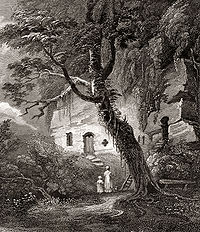Warkworth Hermitage
This article relies largely or entirely on a single source. (March 2012) |
This article includes a list of references, related reading, or external links, but its sources remain unclear because it lacks inline citations. (March 2012) |

Warkworth Hermitage is an unusual relic situated on the North bank of the River Coquet in Northumberland, England, close to the village of Warkworth.
The Hermitage consists of an outer portion built of stone, and an inner portion hewn from the steep rock above the river. This inner part comprises a chapel and a smaller chamber, both having altars. There is an altar-tomb with a female effigy in the chapel.
From the window between the inner chamber and the chapel, and from other details, the date of the work may be placed in the latter part of the fourteenth century, the characteristics being late Decorated. The traditional story of the origin of the hermitage, attributing it to one of the Bertrams of Bothal Castle in this county, is told in Bishop Percy's ballad The Hermit of Warkworth (1771).

The carving in the window is a nativity scene, the female is Mary with the newborn child at her breast; the item at her feet is the head of a bull, and the figure at her shoulder is an angel. Of the dedication crosses placed at the time of its construction only one is visible, the altar was plain the crafety is just that. The ballad is to all intents fiction as the chapel was built as a chantry, and occupied by a series of clergy from 1489 to 1536; since that time it has remained as it is today.
Warkworth Hermitage belongs to English Heritage and is normally open to the public during the summer season.
External links
References
- This article incorporates text from a publication now in the public domain: Chisholm, Hugh, ed. (1911). Encyclopædia Britannica (11th ed.). Cambridge University Press.
{{cite encyclopedia}}: Missing or empty|title=(help)
